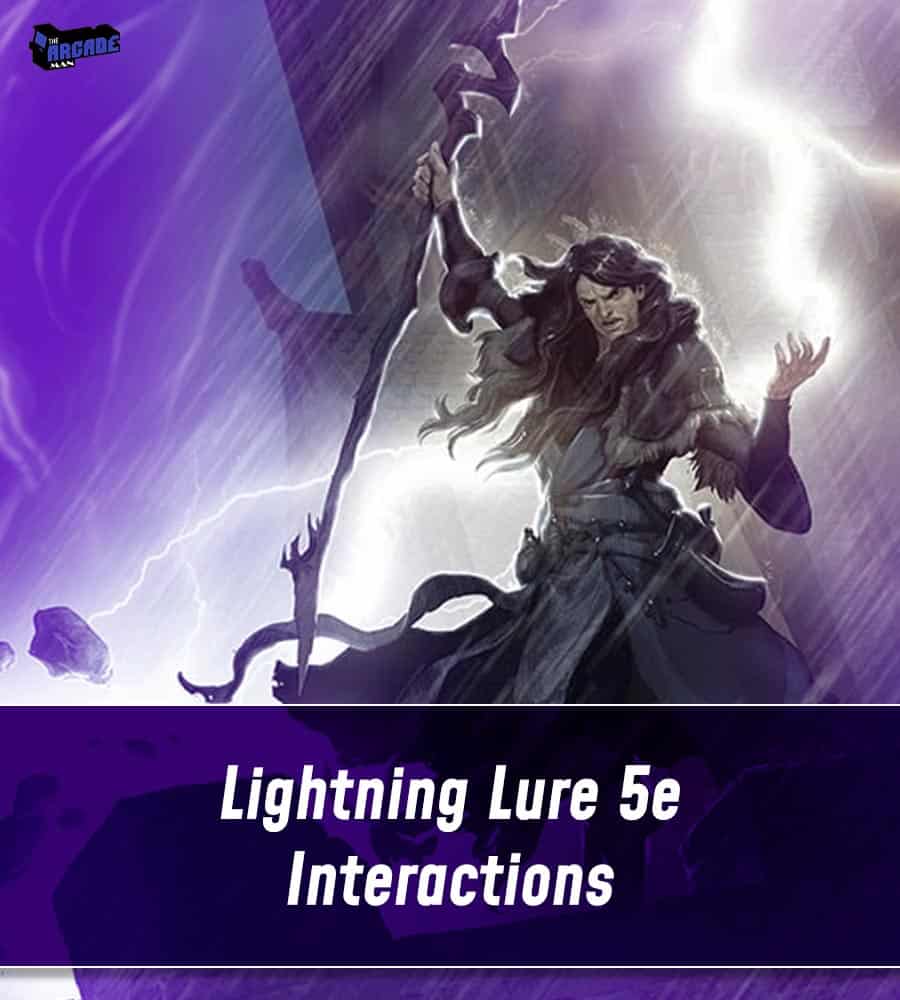Lightning Lure 5e | D&D 5e | The complete Guide

This is a breakdown of the Lightning Lure spell. The Sword Coast Adventure Guide brought over more cantrips than the Green-Flame Blade for lassoing your adversaries! Lightning Lure is a spell that didn’t make our lists of the best cantrips for Wizards, Warlocks, Sorcerers, or even Cantrips.
That doesn’t make it any less valuable; Dungeons and Dragons 5E has a lot of great cantrip possibilities in the early-to-mid game, and you’re about to uncover a new one!
This article will break down everything about the Lightning lure spell in the D&D 5e and guide you on using it the best way possible.
What Is Lightning Lure 5e Spell?
Cantrip Lightning Lure launches a lightning whip right away. The target must succeed on a Strength saving throw or be pulled 10 feet in a straight line toward the player when the player uses the whip to cast a spell attack against it.
Our three main arcane spellcasters each have a mixed utility/damaging spell called Lightning Lure. When a creature within 15 feet attempts a successful Strength saving attempt, the caster draws the creature 10 feet in their direction.
A 1d8 shock is dealt to the caster if it occurs to fall within 5 feet of him. At the fifth, eleventh, and seventeenth levels for 1d8 each, this scales up to 4d8. In terms of cantrips, it provides additional usefulness and very little single-target damage.
| 1st Level | 5th Level | 11th Level | 17th Level | |
|---|---|---|---|---|
| Damage Dice | 1d8 | 2d8 | 3d8 | 4d8 |
| Minimum Damage | 1 | 2 | 3 | 4 |
| Average Damage | 4.5 | 8.5 | 12.5 | 16.5 |
| Maximum Damage | 8 | 16 | 24 | 32 |
Who Can Cast Lightning Lure Spell?
In D&D 5E, any spellcaster with cantrip access can cast Lightning Lure. The following classes have access to cantrips and, therefore can learn Lightning Lure:
- Bard
- Sorcerer
- Warlock
- Wizard
- Arcane Trickster (Rogue subclass)
- Eldritch Knight (Fighter subclass)
Also, some racial traits or feats may grant access to cantrips, such as the High Elf’s racial trait “Cantrip” or the Magic Initiate feat. As long as a character has access to cantrips, they can choose to learn Lightning Lure if it is available to them.
Rules For Using Lightning Lure 5e Spell
Lightning Lure is a spell that creates a lash of lightning energy that can be used to pull a creature toward the caster. The rules for the Lightning Lure 5e spell are as follows:
| Casting Time | 1 action Range |
| Range | 15 feet Components: |
| Components: | V, S |
| Duration | Instantaneous |
| School | Evocation |
- In order to cast the Lightning Lure 5e spell, the caster produces a lash of lightning energy extended from their hands. A caster then chooses a creature within its range and uses a melee spell attack against it. If the attack hits the target, the target takes 1d8 lightning damage, and the caster pulls the target up to 10 feet closer to them.
- If the target cannot move or the spell caster decides not to pull it, the lightning lure spell still damages the target without making it move. If the target succeeds on a Strength saving throw against the caster’s spell save DC, then the target takes no damage and is not pulled toward the caster.
- Lightning Lure 5e spell is a useful cantrip for close-range combat situations, as it allows the caster to cause damage and control the movement of their target.
- Lightning Lure is a useful cantrip for close-range combat situations, as it allows the caster to deal damage and control the movement of their target.
When To Use Lightning Lure 5e Spell?

The spell is situational; however, the range of scenarios in which it can be beneficial is astounding! You can use it to enhance your area spells by drawing your opponents into traps such as Cloud of Daggers.
The effect can aid melee teammates by enticing opponents into positions where they can be flanked or surrounded, preventing escape and increasing damage. When an opponent is flying above your Barbarian’s grasp, and the roof is low, you can drag them down.
Additionally, a Prepared Action can be used with this spell. Forced movement of 15 feet is provided by this spell. When a party member stumbles onto a trap, you are able to pull them out of harm’s path while zapping them on the wrist, stop an enemy from retreating farther than 15 feet, or, if you possess the feat Mage Slayer, drag a caster 15 feet closer while they cast.
Few casters would voluntarily cast that close to a rival caster who was ready to use their spell. Conversely, a good GM could see the wheels turning and give you a chance.
Its utility outside of combat should not be disregarded, either. In the correct circumstances, it may be extremely horrifying and threatening to pull someone ten feet with a line of lightning created without a single physical component. Additionally, you may save lives by using a lightning lasso to yank someone over a cliff edge, surprise or not.
Since this is a spell with saving, you wouldn’t even have to make a Strength check to carry someone wearing heavy armor. This trait gets better if your game master allows you to fail a save purposefully.
Lightning Lure 5e Interactions

Lightning lure, like the green-flame blade and booming blade spells, was altered in Wizards of the Coast’s errata papers in the run-up to the release of Tasha’s Cauldron of Everything.
Fortunately, the lightning lure spell hasn’t changed much, so there are only a few things to remember about how it interacts with other aspects.
1. Twinned Spell
Twinned Spells can be used to lash out at two enemies with Lightning Lure. But Twinned Spell cannot be used on Chain Lightning. Chain Lightning can target up to four creatures, whereas Twinned Card only allows the spell to target one. A spell must be incapable of targeting more than one creature at its current level in order to be eligible for Twinned Spell.
2. War Caster
When a creature provokes you with an opportunity attack, the War Caster feat allows you to cast a spell instead of attacking with a melee weapon. The spell must generally have a casting time of one action and must only target the creature that initiated the chance attack.
Lightning lure only damages one creature, which follows the feat’s requirements, although there is considerable question about what the feat’s range of Self (15 feet) implies.
It’s worth noting that opportunity attacks occur just before a creature exits your grasp. In other words, instead of the standard 15-foot range, you’ll use a lightning lure on a creature within 5 feet of you. You won’t be able to drag the creature away from you, but it will remain within 5 feet of you and absorb the lightning damage.
Lightning Lure 5e Pros & Cons

Lightning Lure 5e Pros
- Since Lightning Lure is a cantrip, there is no need for preparation. Both concentration and resources are not needed to cast it.
- Lightning Lure has the secret advantage of not requiring a Somatic component. As long as you are able to speak, anyone can employ this spell to pull them closer and administer a short zap.
- This spell emphasizes Strength, which is fantastic. Most of the adversaries you would be pursuing would not have strong Strength ratings. Instead, they frequently want to focus on avoiding the adversaries’ line of sight. This suggests that the spell has a strong likelihood of working on the targets you want it to, such as getting the Halfling with the crossbow off the Orc’s back.
- The elemental damage from electricity is also one of the bestiaries’ more easily resisted sources. Thus it will probably slip through many targets unchallenged, although not nearly to the level of force damage.
- Combining this spell with additional AoE effects is another underutilized use. For instance, if your bait pulled your adversary within the area of effect (AoE) of a party member’s spell or even a fire, you may not only lure them in and electrocute them, but you might also further harm them.
Lightning Lure 5e Cons
- The fact that Lightning Lure forces you to engage in melee combat as a caster is a major drawback. There are caster builds that are useful in combat, but the majority of Wizards and Sorcerers ( shadow, divine ) find it difficult to obtain the health to sustain the build. Warlocks ( aasimar warlock ), on the other hand, tend to have decent melee builds, but utilizing one of your precious spell slots on Lightning Lure reduces your ability to use more potent damaging cantrips to complement the damage-dealing function.
- This forced mobility prevents it from launching opportunity assaults on its own. This lessens the power of this spell against reach-extending weapons. Forced mobility also neutralizes other abilities.
- The damage from forced movement is only applied if the target terminates its movement inside 5 feet of you; therefore, it may be halted by having something strong to restrict it, such as high-quality manacles, in which case you don’t get to apply electrical harm to them, even if they fail the Strength save.
- This spell provides only 15 feet of the range from level 1 to level 20, which is a limited range. This cantrip won’t be able to stay up on the usefulness front without a lot of help when substitute abilities that let animals take 100-foot potshots at the party start to surface.
- Finally, since the spell can only be used to target living things, it cannot be used to bring an object to oneself, a la the pseudo-Mage Hand.
Few Lightning Lure Pro Tips
- Use Lightning Lure to pull enemies into range: If an enemy is just outside of your melee range, Lightning Lure can be a great way to pull them closer to you so you can attack them.
- Combine Lightning Lure with an area of effect spell: If you have other spells that deal area of effect damage, you can use Lightning Lure to pull enemies into the area of effect, causing them to take additional damage.
- Target enemies with low Strength save: The Strength saving throw against Lightning Lure is based on the caster’s spell save DC, so targeting enemies with low Strength saves can increase your chances of success.
- Use Lightning Lure to save an ally: If an enemy is attacking an ally and you’re too far away to help, Lightning Lure can pull the enemy away from your ally, giving them a chance to escape.
- Don’t rely on it too heavily: Lightning Lure is a useful cantrip with limitations. It can only be used against enemies within 15 feet and doesn’t deal as much damage as some other cantrips. Ensure you have other spells and abilities to rely on in case Lightning Lure isn’t the best option in a given situation.
Conclusion
The spell’s effectiveness will soon be surpassed by abilities that allow you to control the battlefield better, get near your adversary, and inflict more electric damage on them. Therefore, the only time you can use Lightning Lure is when an enemy is out of range for a movement action, and you truly need them in your range for the next round.
Do you really require Lightning Cantrip? Yes, of course! Any Arcane Skirmisher’s maximum range is extended by 15 feet. You can also do further damage on top of it. They may consider including the Lightning Lure in their arsenal if that sounds attractive. I hope this article has cleared every part about the dnd 5eLightning Lure.






